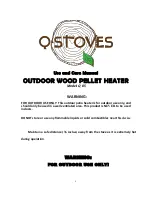
26
Not all materials are considered appropriate fuel
for use in the device, which under no circumstances should be considered an
incinerator. To reach optimal running conditions, we recommend that you
use dry wood with a humidity of less than 20%
and a
drying time of at least one year for tender wood and two years for hard wood. To load firewood, add
three or four logs of 12 to 15
cm in diameter
and 50 cm in length, taking care not to hit the vermiculite coating.
Beech wood is the best for the most optimal process of combustion
followed by other equally recommendable types of wood
such as oak, chestnut, maple ash, elm, poplar and birch.
The use of eucalyptus and pine is not recommended
as they can
produce flames that are too long and can lead to premature wear and tear of the device.
Nor is it recommended to use resinous
woods or woods rich in aromatic oils
(eucalyptus, myrtle) due to the fact that a greater frequency of cleaning is required and may
cause the deterioration of certain parts.
The use of liquid fuel and carbon derivatives
, green wood, fresh or damp wood in particular,
or salvaged wood
(pallets, railway
sleepers, boxes, furniture) is prohibited, as they may cause poorly efficient combustion as well as possible condensation that will
cause the deterioration of the device
Remember that the quantity of energy released in the combustion process, and therefore,
the energy delivered, will depend on
factors like the type of wood used, humidity and quantity.
So, while beech wood with a humidity of 10% can deliver around 4.9
kWh/kg, fresh wood with 60% humidity delivers only 2.8 kWh/kg.
We also recommend that you
open the door gently and slowly
to avoid the sudden introduction of a large quantity of air that emits
smoke and dirt into the room. It is recommend to use gloves or other protection to avoid possible burning.
Never load the device
with a live flame inside.
Wait until there are only embers.
For the
first few uses after purchasing the device, it may produce a certain degree of smoke and odours
while the equip-
ment burns the oil residues from the metal and adapts to the extraction of smoke. Similarly, during normal use, it is also possible to
observe certain traces of condensation caused by logs that are too damp and to hear noises caused by natural expansion
and contraction processes
of the metal components of the device, as they move from a resting atmospheric temperature of 10°C
to 600-650°C.
3.2 Fuel and loading the device
For every lighting of the device, it is necessary to prepare a stack of kindling
, from small 20
cm pieces of wood about 20 cm in length and no more than 2 or 3 cm in diameter. The kindling are
placed at the centre of the fireplace to form a pile, as seen in the image attached. Once the pile is
formed,
add two fire pack lighters to the base and close the door, leaving all the air vents and
draught completely open
When the pile of kindling has turned to embers,
add the second load of small logs of wood to the
pre-load
and wait again with the door closed and the air vents completely open until they become
embers. After the load, the interior of the combustion chamber will reach sufficient temperature,
mak-
ing it possible to load the device fully and regulate the different air control handles
according
to heating needs.
Remember that under cert weather conditions, such as hot days or clouds, ice, rain or humidity, you may have problems lighting.
3.3 Lighting of the device
Pile of kindling
With FERLUX wood-burning ovens you can use the
top-down lighting
method as an alternative to the method described above. This
allows you to take full advantage of this kind of apparatus with the following
advantages
:
- Even less accumulation of dirt on the glass.
- More efficient and homogeneous combustion and with a greater post-combustion
action.
- Longer duration of fire wood.
- Greater comfort for the user, requiring fewer loads.
For top-down lighting, you need
layered fire wood
. At the base of the device, place two or three generously sized logs, similar to a
full load. Above them, lay three or four smaller logs similar to those used in the pre-load and finally a small pile of kindling.
Add the fire pack between the second and third layers, below the pile of kindling, close the door and open both air vent handles fully.
When the pile of kindling is consumed, regulate the air according to heating needs and in line with section 2.3 of this manual.
3.3.1 Top-down lighting
Laying of firewood for top-town lighting







































